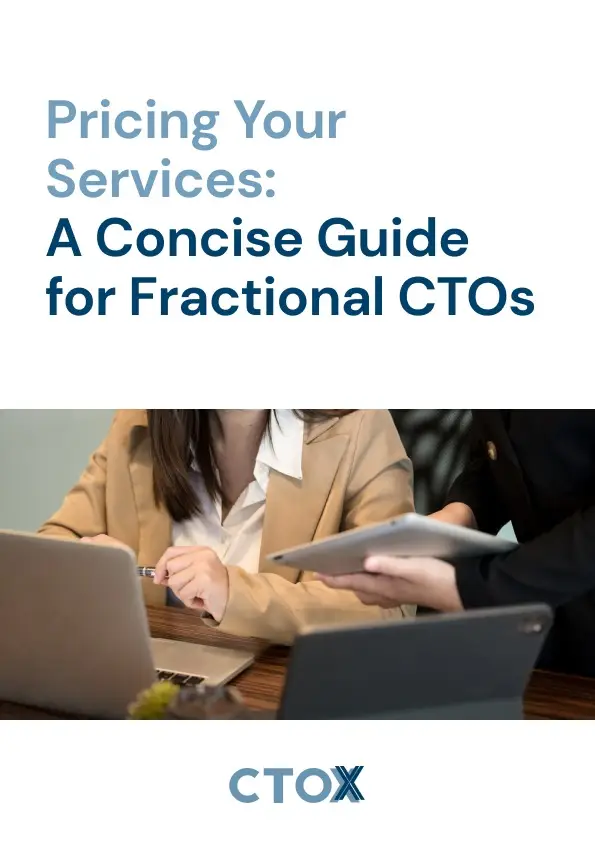Ben's
High-Value Clients.
Benjamin Sanders — Mastering AI-Driven Proposals to Win High-Value Clients.

5/5
“I use AI as a junior team member to close high-value clients”
Key Numbers
-
11 clients closed
-
On track to hit $1 million ARR
-
80% acceptance rate

Who is Ben?
Before CTOx Accelerator™
-
Low proposal acceptance
Early attempts at proposals resulted in only 15–20% acceptance rates.
-
Time-intensive deliverables
Strategy documents, proposals, and client audits consumed excessive hours.
-
Scaling challenge
Transitioning from leading large teams to a fractional CTO role required a way to multiply his impact without working longer hours.
After CTOx Accelerator™
-
AI as a designated team member
Trained Claude 3.7 to understand his voice, thought patterns, and style, effectively acting as a mid-level assistant.
-
Customized, client-specific proposals
Used call transcripts and discovery sessions to generate hyper-relevant proposals rather than generic templates.
-
Iterative co-creation workflow
Collaborated with AI over multiple drafts, refining proposals like a real team review.
-
Knowledge retention with project memory
Built reusable assets, engagement models, and style guides in AI to accelerate future work.
-
Extended AI usage beyond proposals
Created audit questionnaires, workshop agendas, and strategy roadmaps, saving weeks of manual work.
The Challenge
Benjamin Sanders is a lifelong entrepreneur who started consulting as early as the late 1990s, ran a successful digital agency (which he sold in 2017), and has held multiple CTO roles across advertising, publishing, and fintech.
As a self-described “emerging technologist,” Benjamin has always been at the forefront of new tools, including predictive analytics, quantum computing, and AI. After leaving corporate roles behind, he focused on building a flexible fractional CTO business that honors his values: self-direction, time freedom, and high-leverage impact.
Transitioning from running large teams to operating as a fractional CTO, Benjamin needed a way to scale himself — particularly for time-intensive deliverables like proposals and strategy documents. In early iterations, his proposal acceptance rate hovered around 15–20%, which he found too low given the quality of conversations he was having.
The CTOx®
Approach
- Deep use of AI as a delegated team member: Benjamin approached AI (specifically Claude 3.7) as a mid-level assistant or account executive rather than just a text generator. He trained AI to use his voice and thought patterns by providing writing samples and prior proposals.
- Customized proposals that speak directly to client pain points: Instead of generic templates, Benjamin used transcripts from stakeholder calls and discovery sessions as input data, allowing AI to generate hyper-relevant proposals.
- Iterative co-creation process: He didn't stop at one draft: he repeatedly asked AI to cross-check against transcripts, fix misalignments, and suggest refinements — like a real collaborative team review.
- Leveraged project-based memory: By using Claude’s “Projects” feature, he maintained a corpus of reusable knowledge, such as his engagement models, assets from CTOx, and his own style guides.
- Extended beyond proposals to workshops and onboarding: After securing clients, Benjamin used AI to create custom asset audit questionnaires, kickoff workshop agendas, and initial strategy roadmaps — saving weeks of manual work.
CTOx® Methodologies Used:






The Transformation
High Proposal Acceptance
Proposal acceptance rate jumped from ~20% to 80% after switching to Claude and this iterative prompting approach.
Rapid Uptick In Conversion
Multiple new retainers signed within weeks of adopting the updated AI-driven workflow.
Huge Time Savings
Proposals and audit materials that used to take 10–20 hours now take as little as 2–3 hours to finalize.
Client Resonance Accuracy
Clients responded with comments like “You exactly captured the challenges we’re having — where do we sign?”
Real Results
-
Higher Acceptance
Proposal acceptance rate jumped to 80% – Dramatically improved conversion from 15–20% using AI-driven workflows.
-
Rapid Engagements
Faster client acquisition – Multiple new retainers signed within weeks.
-
Brutal Efficiency
Huge time savings – Deliverables that previously took 10–20 hours now take 2–3 hours.
-
High Relevance
Massive client resonance – Clients consistently responded positively, feeling understood and confident in Benjamin’s solutions.
-
Annual Revenue
On track to close $1million in ARR, achieved efficiently through AI-augmented processes
What Can You Learn From Ben?
-
Delegate to Scale
Treat AI as a capable team member rather than just a tool.
-
Hyper-relevance Wins
Tailor proposals and deliverables to client-specific pain points for higher acceptance.
-
Iterate, Don’t Settle
Use multiple rounds of refinement to improve quality and resonance.
-
Leverage Reusable Knowledge
Build templates, style guides, and project memory for faster future execution.
-
Time Freedom is Achievable
Efficient systems allow high-value work without overloading yourself.
FAQs About the CTOx® Journey
Common questions technology leaders ask when exploring the fractional CTO path, answered based on patterns we’ve observed across hundreds of successful members.
What kind of background do successful CTOx Accelerator™ members typically have?
Most successful CTOx Accelerator members are experienced technology leaders with 10+ years in the industry, including current or former CTOs, VPs of Engineering, Technical Directors, and Senior Engineering Managers. They typically have experience leading teams, making strategic technology decisions, and working directly with executive leadership. Many come from startups, scale-ups, or enterprise environments where they’ve been responsible for technology strategy, not just implementation.
How long does it usually take CTOx Accelerator™ members to get their first client?
The most proactive CTOx Accelerator™ members typically land their first client within 30-90 days of joining the program. Some exceptional cases have signed clients within their first week, while others may take longer depending on their network activation efforts and niche focus. The timeline largely depends on how consistently members implement the Network Activation process and execute on the business development activities outlined in the program.
What are the most common challenges people face when transitioning to fractional CTO work?
The three most common challenges are: (1) Overcoming discomfort with business development and “marketing” activities, (2) Shifting from hourly thinking to value-based pricing and retainer models, and (3) Learning to delegate tactical work while focusing exclusively on strategic leadership. Many also struggle initially with positioning themselves in a specific niche rather than trying to serve everyone.
What types of client engagements and revenue models do CTOx Accelerator™ members typically build?
CTOx Accelerator™ members typically build diversified portfolios with two main engagement types: “Engaged” clients (full strategic leadership at $10k-$15k/month) and “Advisor” clients (high-level guidance at $3k-$5k/month). Many also offer strategic intensives or half-day consults as entry points. Successful members often manage 5-8 total clients with a mix of engagement levels, targeting $500,000+ annual revenue through this diversified approach.
What advice do most CTOx Accelerator™ members give to technology leaders considering this transition?
The most consistent advice from CTOx Accelerator™ members is: (1) Start while still employed to reduce financial pressure, (2) Focus on a specific niche rather than trying to serve everyone, (3) Leverage your existing network through the Network Activation process before trying cold outreach, and (4) Embrace relationship-based business development rather than traditional marketing. They also emphasize the importance of following the proven system rather than trying to figure everything out independently.
